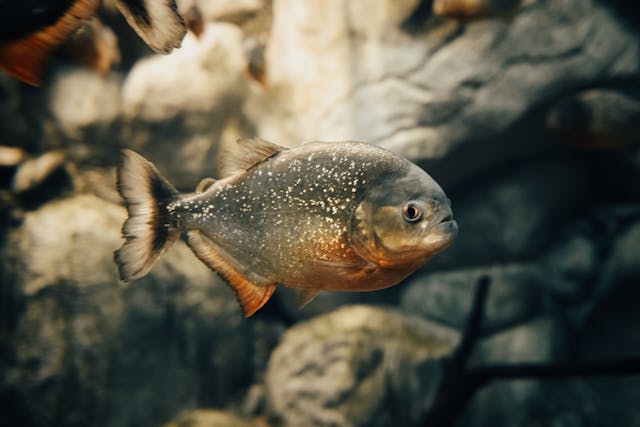
Do piranhas eat meat? They do, but not very often and they are not the carnivores that we have been led to believe. Many people fear piranhas and they have been used in movies as a plot device. In the James Bond movie, You Only Live Twice, one of the characters was fed to piranhas, which ate her alive. In real life, she might have had a bite or two on the feet, but that would be it.
There are between 30 and 60 different types of piranhas. The name “piranha” comes from the Tupi people, which were the largest group of indigenous people in Brazil before it was colonized by the Spanish. The name comes from “pira”, which means fish, and “sainha”, which means tooth. Piranhas are native to South America. Piranhas and not very big fish. They are between 12 and 35 cm long.
Piranhas are famous for their teeth. They have about twenty teeth, divided between their top and bottom jaws. The teeth are triangular and interlock with each other. They are very sharp. Piranhas can do a lot of damage with their teeth, but it is their bite force that is exceptional. Their bite force has been measured at 320 Newtons, which is an incredible force for something so small. A great white shark has a bit force of 18,000 Newtons, but a great white shark generally weighs about 2,000 kg. A Newton is the force required to move a kilogram of mass by one meter. So, a great white shark’s bite force is only about 9 times more than its body weight. A piranha weighs less than a kilogram and it has a bite force of 320 Newtons, which is over three hundred times its body weight! The piranha is able to do this because it has very large and very strong jaw muscles that are attached close to the tip of its jaw. Why do piranhas need such strong jaws? They eat by tearing the flesh off things and this is easier to do with sharp teeth and strong jaws. The jaws give them the power to slice through anything and then they can grip and use their bodies to pull the food off.
So, with these sharp teeth and very strong jaws, piranhas must be the most dangerous fish in the rivers? No, it turns out that they are not dangerous. Since 2007, there have been several hundred attacks by piranhas, but they have all been single bites on the feet or the hands. Occasionally, there are cases of more than one bite, but even these are not major attacks. Piranhas do not attack people and the few attacks on record were made by mistakes. In the same way that great white sharks attack people thinking them to be seals and then release them, piranhas do the same. There are a few accounts of piranhas killing small children, but it is not known if the piranhas were the culprits or if the children drowned and were then attacked by the piranhas.
Piranhas are thought to be carnivores, but they are actually omnivores. They eat pretty much anything they can get their teeth into. They eat seeds, fruit, leaves, insects, crustaceans, worms, other fish, small mammals, and occasionally larger mammals. They have been known to eat large animals, but these animals have almost always died and fallen into the river, or have been very sick and almost dead. Piranhas are scavengers more than they are hunters. They swim in large shoals, and they can make short work of a dead animal, but they swim in groups for their own safety, rather than to be able to kill more prey. Piranhas are very small fish and they are prey for many other animals. They are eaten by dolphins, caimans, birds, and, of course, us. They are very nervous and timid fish.
An American tropical fish expert called Herbert Axelrod actually tested this hypothesis. He waded into a tank full of piranhas wearing only his speedos and carrying a piece of raw meat. After a while, the piranhas ate the meat, but not a single one of them bit him. They only bite people if they confuse us with another animal that they think might be food. When they find out they are wrong, the back off. They do occasionally get aggressive if they are stressed or if the water levels are low, but this is very rare. And this is what I learned today.
Photo by Guryan: https://www.pexels.com/photo/red-bellied-piranha-in-close-up-shot-13561545/
Sources
https://en.wikipedia.org/wiki/Herbert_R._Axelrod
https://seaworld.org/animals/facts/bony-fish/piranhas
https://en.wikipedia.org/wiki/Piranha
https://en.wikipedia.org/wiki/Tupi_people
https://theworld.org/stories/2016/07/31/piranha-may-have-worlds-strongest-bite
https://www.sciencefocus.com/nature/how-powerful-is-a-great-white-sharks-jaw
